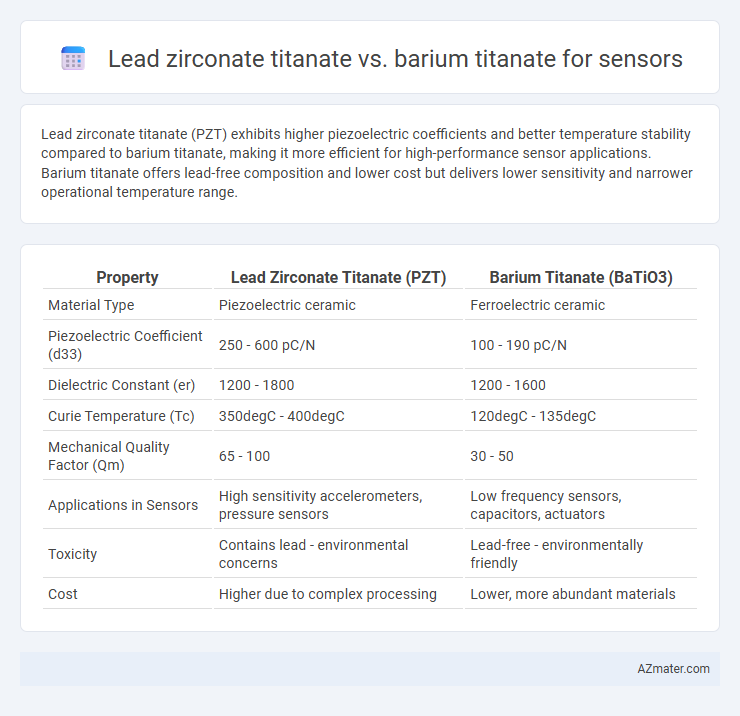Lead zirconate titanate (PZT) exhibits higher piezoelectric coefficients and better temperature stability compared to barium titanate, making it more efficient for high-performance sensor applications. Barium titanate offers lead-free composition and lower cost but delivers lower sensitivity and narrower operational temperature range.
Table of Comparison
| Property | Lead Zirconate Titanate (PZT) | Barium Titanate (BaTiO3) |
|---|---|---|
| Material Type | Piezoelectric ceramic | Ferroelectric ceramic |
| Piezoelectric Coefficient (d33) | 250 - 600 pC/N | 100 - 190 pC/N |
| Dielectric Constant (er) | 1200 - 1800 | 1200 - 1600 |
| Curie Temperature (Tc) | 350degC - 400degC | 120degC - 135degC |
| Mechanical Quality Factor (Qm) | 65 - 100 | 30 - 50 |
| Applications in Sensors | High sensitivity accelerometers, pressure sensors | Low frequency sensors, capacitors, actuators |
| Toxicity | Contains lead - environmental concerns | Lead-free - environmentally friendly |
| Cost | Higher due to complex processing | Lower, more abundant materials |
Introduction to Lead Zirconate Titanate and Barium Titanate
Lead zirconate titanate (PZT) and barium titanate (BaTiO3) are prominent ferroelectric materials widely used in sensor applications due to their strong piezoelectric properties. PZT, a complex perovskite oxide with a chemical formula Pb[Zr_xTi_1-x]O_3, exhibits superior electromechanical coupling coefficients and temperature stability, making it ideal for high-performance sensors. BaTiO3, a simpler perovskite oxide, offers excellent dielectric permittivity and is preferred for low-frequency sensing devices, though it generally provides lower piezoelectric response compared to PZT.
Material Structures and Chemical Composition
Lead zirconate titanate (PZT) features a perovskite crystal structure with a complex chemical composition of Pb(Zr,Ti)O3, known for its strong piezoelectric properties due to the presence of lead, zirconium, and titanium ions arranged in a distorted oxygen octahedron. Barium titanate (BaTiO3) also exhibits a perovskite structure but consists of barium, titanium, and oxygen, displaying ferroelectric behavior with phase transitions that affect its dielectric and piezoelectric performance. The higher lead content in PZT contributes to superior electromechanical coupling and sensitivity in sensor applications compared to the lead-free barium titanate.
Piezoelectric Properties Comparison
Lead zirconate titanate (PZT) exhibits significantly higher piezoelectric coefficients (d33 up to 600 pC/N) compared to barium titanate (BaTiO3), which typically demonstrates values around 100-190 pC/N, making PZT more efficient for sensor applications requiring high sensitivity. PZT's superior electromechanical coupling factor and temperature stability enhance its performance in dynamic sensing environments, whereas BaTiO3 is favored for lead-free applications but suffers from lower piezoelectric efficiency. The choice between PZT and BaTiO3 for sensors hinges on balancing performance demands with environmental and regulatory considerations related to lead content.
Dielectric Constants and Capacitance Performance
Lead zirconate titanate (PZT) exhibits a significantly higher dielectric constant, typically ranging from 300 to 1000, compared to barium titanate (BTO), which usually ranges between 100 and 500, making PZT more suitable for high-sensitivity sensor applications. The higher dielectric constant of PZT directly enhances its capacitance performance, enabling better charge storage and signal detection in piezoelectric sensors. Barium titanate, while having lower dielectric constants, offers advantages in temperature stability and lower dielectric loss, but PZT remains preferred for applications demanding superior capacitance and dielectric responsiveness.
Sensitivity and Signal Output in Sensors
Lead zirconate titanate (PZT) exhibits higher piezoelectric coefficients than barium titanate (BaTiO3), resulting in superior sensitivity and enhanced signal output in sensors. PZT's tetragonal perovskite structure enables efficient charge displacement under mechanical stress, making it ideal for high-precision sensor applications. In contrast, BaTiO3 offers lower sensitivity but better temperature stability, which may be preferred for specific environmental conditions.
Response Time and Frequency Characteristics
Lead zirconate titanate (PZT) exhibits superior response time and frequency characteristics compared to barium titanate (BaTiO3) in sensor applications due to its higher piezoelectric coefficients and electromechanical coupling factors. PZT sensors operate effectively at higher frequencies with rapid signal transduction, making them ideal for dynamic sensing environments. Barium titanate shows slower response times and lower frequency bandwidth, limiting its use in high-frequency or fast-response sensor systems.
Temperature Stability and Environmental Robustness
Lead zirconate titanate (PZT) exhibits superior temperature stability compared to barium titanate (BaTiO3), maintaining consistent piezoelectric properties across a wider temperature range, typically up to 300degC. Barium titanate shows strong sensitivity at lower temperatures but suffers from phase transitions that reduce stability above 120degC, limiting its effectiveness in high-temperature sensor applications. PZT also demonstrates enhanced environmental robustness, resisting moisture and mechanical fatigue better than BaTiO3, making it a preferred choice for sensors in harsh or variable environments.
Durability and Longevity in Sensor Applications
Lead zirconate titanate (PZT) exhibits superior durability and longevity in sensor applications due to its high piezoelectric coefficients and resistance to mechanical fatigue, outperforming barium titanate (BaTiO3), which tends to degrade faster under cyclic loading. PZT's stable perovskite structure ensures consistent sensor performance over extended operational periods, while BaTiO3 may suffer from reduced sensitivity and lifespan in harsh environments. The enhanced fatigue resistance and thermal stability of PZT make it the preferred choice for high-demand sensor applications requiring long-term reliability.
Manufacturing Processes and Cost Implications
Lead zirconate titanate (PZT) offers superior piezoelectric properties over barium titanate (BaTiO3), making it highly effective for high-performance sensors, but its manufacturing involves complex processes like sol-gel and tape casting that increase production costs. Barium titanate, while exhibiting lower piezoelectric coefficients, benefits from simpler and more environmentally friendly sintering methods, resulting in reduced manufacturing expenses. Cost implications favor barium titanate for large-scale, cost-sensitive sensor applications, whereas PZT remains preferred for precision sensors despite higher fabrication expenditures.
Application Suitability: PZT vs. Barium Titanate in Modern Sensors
Lead zirconate titanate (PZT) offers superior piezoelectric coefficients and higher Curie temperatures, making it ideal for high-sensitivity and high-temperature sensor applications. Barium titanate, with its lower dielectric losses and excellent ferroelectric properties at room temperature, suits low-power, cost-effective sensors with moderate performance requirements. PZT is preferred in advanced industrial and medical sensors, while barium titanate excels in consumer electronics where environmental stability and cost are critical.

Infographic: Lead zirconate titanate vs Barium titanate for Sensor
 azmater.com
azmater.com